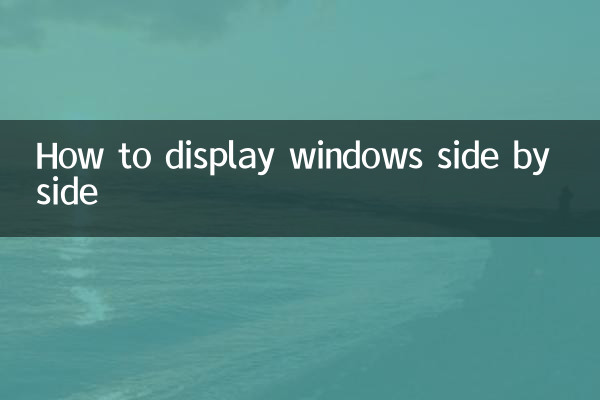How to Display Windows Side by Side: Practical Tips for Multitasking Efficiency
In today's fast-paced work and learning environment, multitasking has become the norm. Displaying windows side by side can help us handle multiple tasks at the same time more efficiently and improve productivity. This article will introduce in detail how to display windows side by side in different operating systems, and attach recent hot topics and hot content for readers' reference.
1. How to display windows side by side in Windows system

The Windows system provides a variety of ways to display windows side by side. The following are some common methods:
| method | Operation steps | Applicable scenarios |
|---|---|---|
| Shortcut key split screen | 1. Select the window and press Win+Left/Right Arrow 2. Select another window and press Win+reverse arrow | Quickly split two windows left and right |
| Mouse drag | 1. Drag the window to the left/right edge of the screen 2. Release the mouse to automatically resize | Suitable for users who are accustomed to mouse operations |
| task view | 1. Press Win+Tab to open task view 2. Right-click the window and select "Show Side by Side" | Manage multiple window combinations |
2. How to display windows side by side in macOS system
Mac users can also achieve side-by-side windows in the following ways:
| method | Operation steps | Remark |
|---|---|---|
| Split screen function | 1. Long press the green button in the upper left corner of the window 2. Choose to tile the window to the left or right side of the screen | Requires macOS 10.11 and above |
| Mission Control | 1. Swipe up with three fingers or press Control+↑ 2. Drag the window to a different desktop | Ideal for multi-monitor environments |
| Third party tools | Magnet, BetterSnapTool and other applications | Provides more flexible split-screen options |
3. Tips for side-by-side display of windows in Linux systems
Because of its high customizability, Linux systems provide more window management options:
| desktop environment | How to operate | Features |
|---|---|---|
| GNOME | 1. Drag the window to the edge of the screen 2. Use Super+left/right shortcut keys | Similar to Windows operating logic |
| KDE Plasma | 1. Right-click the title bar and select "Tile" 2. Use KWin script to extend functions | Highly configurable |
| Tile WM | Window managers such as i3 and Awesome | Automatically manage window layout |
4. Recent hot topics and hot content (last 10 days)
According to the entire Internet search, the following are topics that have received widespread attention recently:
| Topic Category | Popular content | heat index |
|---|---|---|
| science and technology | Apple Vision Pro release experience | ★★★★★ |
| entertainment | Spring Festival movie box office war | ★★★★☆ |
| physical education | Asian Cup football highlights | ★★★☆☆ |
| society | Reports on Spring Festival folk activities in various places | ★★★☆☆ |
| healthy | Winter respiratory disease prevention and treatment | ★★★★☆ |
5. Advanced techniques for displaying windows side by side
1.Virtual Desktop Extension: Most modern operating systems support virtual desktops, which allow you to create multiple workspaces and assign different types of applications to different desktops.
2.Monitor color calibration: When using multiple monitors, it is important to ensure color consistency, which can be calibrated using tools such as DisplayCAL.
3.Recommended window management tools:
4.Shortcut key customization: Adjusting split-screen shortcut keys according to personal habits can greatly improve work efficiency.
6. Best practices for multi-window work
1. Place the reference document on the left screen or window and the workspace on the right
2. Place the instant messaging tool on the secondary monitor or window corner
3. During video conferences, arrange presentation documents and participant windows separately
4. When developing programming, keep the code editor and the running result window visible at the same time
Mastering the technique of displaying windows side by side allows us to handle multitasking with ease and avoid the efficiency loss caused by frequent window switching. I hope the methods introduced in this article can help readers create a more efficient work environment.

check the details

check the details